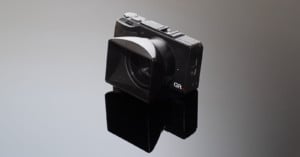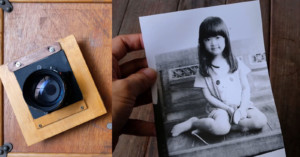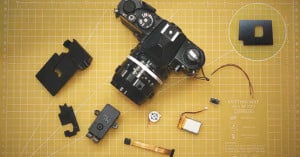
Converting a 103-Year-Old Zeiss Lens to Autofocus M-Mount
Recently I was rummaging around in a box of old cameras, and I stumbled across a cute little Zeiss lens that I didn’t even know I had.

Recently I was rummaging around in a box of old cameras, and I stumbled across a cute little Zeiss lens that I didn’t even know I had.

Photographer Jim Skelton is well known for his expansive collection of Polaroid cameras, dating back to the very first Polaroid Land cameras in 1963. Skelton aims to help photographers revive these automatic Polaroid pack film cameras to use manual shutter speeds and different film formats.

Released in 1971, the Polaroid Big Shot was a funky, green plastic camera that was built for one thing: portraits. The plastic behemoth is simply designed, using a fixed focus 200mm, single-element plastic meniscus lens.

In this era of ubiquitous high-resolution color screens, it seems hard to recall that photography established itself without color. The medium earned its position in the worlds of journalism, popular culture, and fine arts long before Kodak introduced color film. But this does not relegate black-and-white photography to the basement. The genre remains powerful, present, and widely practiced today, with both film and digital cameras.

Picsart has created a website that hosts 19 image and video editing tools that can be accessed for free in a drag-and-drop format. It supports a ton of tasks from resizing, file type conversion, background removal, color pickers, and more.

Omnar Lenses, a new optics manufacturer based out of the United Kingdom, has announced a partnership with Skylanney Opto-Mechanics to offer a new one-off service that will turn any non-rangefinder lens into a rangefinder coupled M-Mount lens.

For a long time now, I've been looking a little enviously in the direction of Leica because of the monochrome versions of the M and Q models.

I previously shared how I converted my Afghan Box Camera into a slide projector. The principle of the slide projector involves putting a light source at the back whose light passes through some condenser lens. The light then goes through the slide, passes through the projector lens, and is projected at a larger size on the projector screen.

Avalanche is a photo migration software by developer Cyme that can be used to convert one photo catalog into another without losing any data. Today it announced compatibility with Skylum Luminar 4 and AI, allowing Lightroom, Aperture, and soon Capture One catalogs to be turned into Luminar catalogs.

Japanese tinkerer Sanasol has just released a detailed, step-by-step "blueprint" video that shows you exactly how he was able to transform his classic Nikon FM film SLR into a digital camera without harming the film camera at all. If you have a few bucks to spend and a 3D printer handy, you can even follow along.

The 'I'm Back' is ... well ... back. The digital converter that lets you add a sensor to old 35mm SLRs (and, later, medium format cameras) is back on Kickstarter with a new-and-improved model that expands compatibility to more old cameras, adds a manual shooting mode, and more.

Nikon introduced the Nikon D850 in 2017 with a 45.7-megapixel backside-illuminated (BSI) Nikon-specified/Sony-designed/TowerJazz manufactured sensor. The Nikon D850 is regarded as one of Nikon's best cameras and continues to range at the top of consumer DSLRs.

Are you looking for an affordable but also electronic macro lens? Or maybe you have an old kit lens that's just sitting around, collecting dust since your last upgrade? Well then read on, because in this article I am going to share one cool hack that will allow you to transform almost any kit or standard zoom lens into a capable macro lens!

We've seen some unusual camera modding projects before, but this one is next level. Someone over in China took a $2,500 Sony a7R III, took it apart, and, through an insane amount of work, turned it into a $5,000 Leica Q2.

I recently converted my friend's Durst Laborator 1200 enlarger to use LED lights. In this article I'll share how I did it.

Have you ever used Photoshop’s Calculations Tool? It allows you to quickly blend two images together with optional blend modes and opacity. This 10 minute video from PIXimperfect explains how the tool works, and how it can be used to quickly convert a color image to black and white.

Ever since the advent of digital cameras, some film photographers have dreamed of having a way to convert their beloved film cameras into digital ones. Photographer Robin Guymer took matters into his own hands: using his knowledge of electronics, he converted a Sony NEX-3 mirrorless camera into a digital back for his film Nikon FE SLR camera.

The Leica M Monochrom is special in the Leica lineup due to the fact that it lacks a color filter, which improves image quality and restricts the camera to shooting black and white. If you'd like a monochrome-only camera but don't want to shell out $7,450 for the latest Leica M Monochrom, there are now converted Fujifilm cameras for a cheaper alternative.

Launched back in 2012, the Impossible Instant Lab is a device that prints out your iPhone photos as Impossible instant photos. But what if you want to use the Instant Lab itself as an instant camera instead of an instant printer?
The Vienna-based brand SUPERSENSE has a solution. Today the analog brand announced the Lab2Cam Conversion Kit, which allows you to transform your Instant Lab into an instant camera by mounting a Polaroid SX-70 lens to it.

The Rodenstock XR-Heligon 50mm 0.75 lens is an old lens that was made for medical X-ray imaging by the German optics company Rodenstock. You can find them for sale on eBay these days for $50 and up.
Greek photographer Haris Antonopoulos and his buddy Thanasis Ioannidis recently decided to take one of these lenses and turn it into the world's fastest lens for Sony E-mount cameras through a physical conversion.

After founding The Impossible Project to revive Polaroid-style instant film in 2008, Florian Kaps announced his retirement from the company in May 2013. Kaps latest venture is the Vienna-based SUPERSENSE, which is a coffee house, store, photo and music studio, and workshop all rolled into a single space.
SUPERSENSE today announced that it's making 20x24 Polaroid photos available to photographers around the world. Simply send in a digital photo, and they'll ship you a gigantic 20x24-inch Polaroid picture.

Photographer Mario Nagano has a new camera lens that will undoubtedly draw quite a few looks from fellow photographers: it's an old lens from a 1950s bellows camera that has been converted into a Micro Four Thirds lens for his Olympus OM-D E-M5.

Motorola Mobility has been ordered by a court ruling to fork over $10.2 million to Fujifilm for violating one of the Japanese company's camera patents in its mobile phones.

I had a fun, cool portrait shoot with Pharrell Williams recently in a small suite at the Beverly Hilton Hotel. Most of my celebrity portrait assignments are in hotel rooms and the first thing you have to consider when you arrive is: How do I turn a room I've seen a thousand times into a photo studio?

Ollie Baker, the 18-year-old tinkerer who made headlines when he turned an old Konica rangefinder into a digital camera using a Sony NEX-5 sensor, is back at it with a Kickstarter project that's even more exciting: he wants to turn your Leica M3 into a digital camera by packing the full-frame sensor from the Sony a7 inside!

“Until the 20th century, 'reality' was everything humans could touch, smell, see and hear. Since the initial publication of the chartered electromagnetic spectrum... humans have learned that what they can touch, smell, see and hear is less than one millionth of reality.”
When it comes to the type of glass used in still photography, versus the glass used in motion picture, there’s quite a dramatic difference in design, quality and price. Quite often, it's the last of those differences that is the most inhibiting for photogs who want to dabble around in motion picture.
To help ease that transition, Caleb Pike of DSLR Video Shooter has broken down a way in which you can convert still photography lenses into psuedo-cine lenses at minimal cost.

Whether you're just starting to convert color to black and white or you've just never been satisfied with how your previous attempts have turned out, this short tutorial by Hong Kong street photographer Gary Tyson will come in very handy.

It's hardly news that Google+ is doing its damnedest to secure itself as the social network of choice for the photographic community. And the network's ability to handle full-size RAW uploads, in addition to the easy-to-manage system and powerful new in-browser editing tools, in many ways already makes it a shoo-in for that title.
But get ready, because Google isn't done yet. Another update has been pushed Google+'s way, and this time it concerns your RAW photos. Or, more specifically, how good they look when they're automatically converted to JPEGs for viewing.

The rumor was true -- kinda. Sigma today announced a new Mount Conversion Service for its Global Vision line of lenses that will allow photographers to convert their lens lineups to different mounts if they ever decide to change camera brands (e.g. Canon to Nikon and vice versa).
Unlike what was previously rumored, it's not a free service: the conversion will cost you a pretty penny -- just not as much as you'd pay to buy a new copy of the lens.

When The Impossible Project announced its Impossible Instant Lab back in September 2012, it turned to Kickstarter to raise $250,000 to fund the project. After the Internet got wind of the smartphone-to-instant-photo printing device, the fundraising campaign blew past its goal and ended up with a total of $559,232 from 2,509 supporters.
Today the company announced that the Impossible Instant Lab will be hitting store shelves on August 29th, 2013 for a retail price of $299.

Older Sigma lenses that were designed for Canon EOS film cameras often don't work correctly when mounted onto a new EOS digital SLR, even though the newer bodies still use Canon's EF mount. If you're an owner of such a lens, you might have heard that you can send it in to Sigma's service center for them to rechip it in order to make it compatible again.
Did you know that those of you who are handy with electronics can actually do the rechipping yourself at home? Photographer Martin Melchior recently did this with his Sigma 70-210 f/2.8 APO lens, and says that anyone with basic soldering skills can do the same.

Newer Leica lenses have a special lens code on the mount flange of each lens that informs the camera of what's mounted on it, and allows lens-related EXIF data to be embedded inside photographs. If you have an older Leica lens or a third-party lens on your hands, you might not have this special code, but did you know that you can apply the code manually to a code-less lens using black and white paint?
La Vida Leica! has published a tutorial showing how simple the process is: it only takes around $15 and 15 minutes to do.

Remember that slow-motion wildlife footage that consisted entirely of still photos animated with parallax? French photographer Sebastien Laban does the same thing, except with his wedding photographs.
In the video above, all the apparently 3D scenes you see are actually the result of using some After Effects magic on ordinary 2D photographs.

Launched in 1992 and discontinued in 1996, Nikon's Nikonos RS was considered one of the best underwater photography solutions back in the 90s. The cameras and the 50mm f/2.8 macro, 28mm, 13mm fisheye, and 20-35mm lenses still sell for relatively high prices these days. Unfortunately for Nikon enthusiasts, the RS mount lenses were not compatible with F mount cameras... until now.
Underwater photographer Andrej Belic spent over a decade dreaming of using an RS lens on his Nikon DSLR, and over the past year he was able to get the combo working.

Photographer Bryce Hoeper wants to become the Dr. Frankenstein of the camera world. Back in 2011, his experiments with mounting a 102-year-old lens to a Canon DSLR were widely shared across the Web. About a month ago, he created another cam-monster that combines old and new: he combined an old Speed Graphic 4x5 large format camera with a modern Fujifilm X-Pro1 mirrorless camera.

Whoa... Big news on the camera patent scouting front today: Nikon appears to be tinkering with the idea with creating a special 35mm SLR replacement back that would turn a film camera into a digital camera!

We've shared some interesting digital to analog conversions here in the past (e.g. printing iPhone photos using an enlarger), and here's another one: create a digital wet plate by shooting a photo displayed on your computer monitor.

Slovenia-based professional photographer Borut Peterlin was recently tasked with shooting a portrait of painter/illustrator/author Milan Erič for influential Slovenian magazine Mladina. Peterlin decided that he wanted to create a wet plate collodion photo, but spent weeks worrying about whether he would be able to accomplish it given the tight schedule of the on-location shoot.

Have an old Polaroid camera lying around collecting dust? Did you know that you can use it for wet …